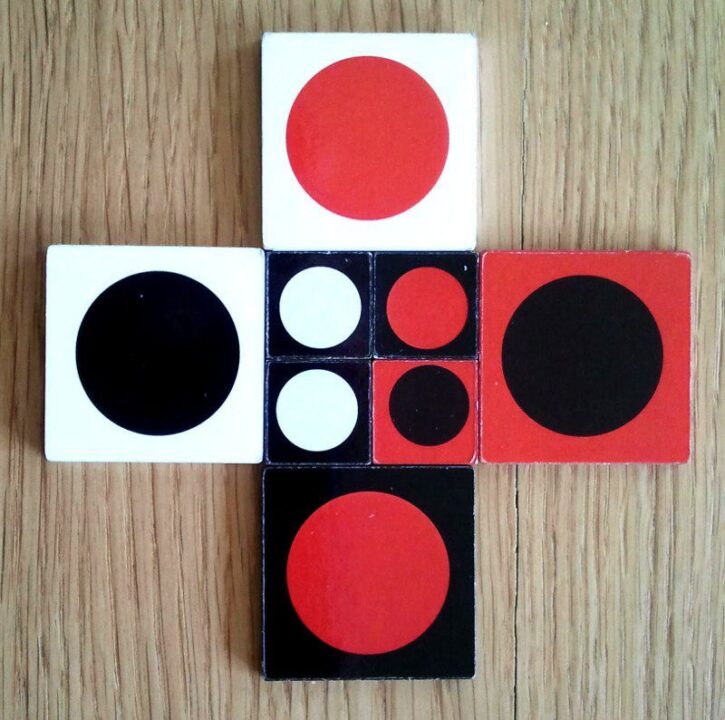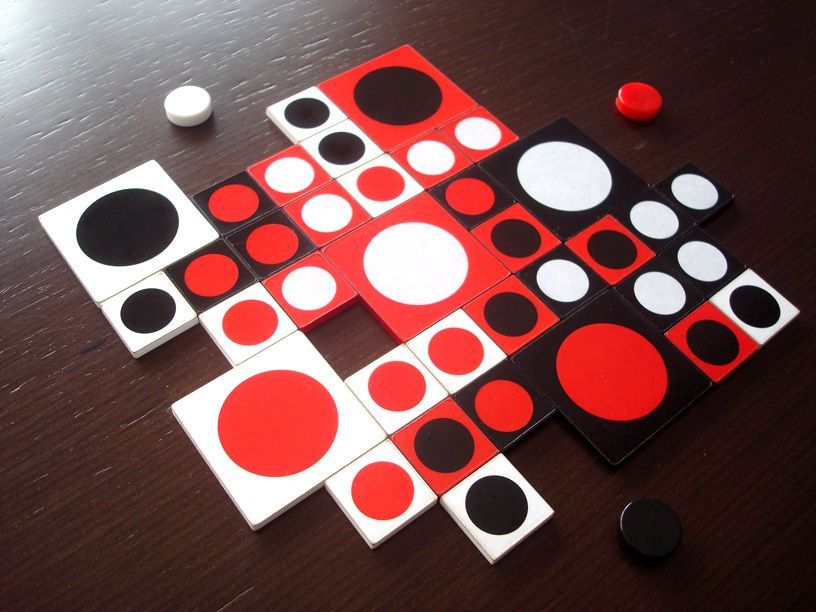If you’ve ever lost a friendship over a board game, buckle up, because I’m about to review a wild one. Red hit my table last Friday and, let’s just say, things got real loud, real fast. Whether you’re the type to plot three moves ahead or just play for the giggles, this game has a little something for everyone—except, perhaps, folks who like to blame bad luck for their terrible decisions. Let’s see if Red deserves a spot on your shelf, or if it’s just another box gathering dust behind the Monopoly set.
How It Plays
Setting up
Open up the box, and try not to lose any pieces under the table (my dog still has my last red token). Hand each player a card stand and deal out the starting hand of cards. Put the deck in the middle, where everyone can reach it (unless you have freakishly short arms, then scoot closer).
Gameplay
Each turn, play a card to your tableau, or swap cards between your hand and the board. The trick is to always have the highest value row in front of you, but sneaky friends will constantly mess up your plans. Expect groans, table talk, and at least one person looking confused by the rules (usually me). Keep an eye out for that lucky draw, but know skill will outshine a lucky streak.
Winning the game
The round ends when everyone but one player passes. The player with the highest current row in front of them (not tucked away in their sleeve, looking at you Dave) wins the round. Play a set number of rounds and count up those sweet, sweet points. Whoever has the most points at the end wins bragging rights. Prepare your victory dance, but keep it PG for grandma.
Want to know more? Read our extensive strategy guide for RED.
How ‘red’ Keeps You On Your Toes: Gameplay Flow and Turn Structure
Alright, get ready for the fast lane, because the gameplay in red zips along like someone forgot their brake pedal. The rules do a good job keeping turns brisk but not so quick that your cousin Dave (the over-thinker) can’t keep up. In each round, play moves clockwise, starting with whoever ate the most spicy food that day—or the youngest player if you don’t like fire in your belly.
On your turn, you don’t just toss a card and hope for the best. Each player gets a hand of cards and needs to choose one to play, keeping in mind not just their own plans but also what the sneaky guy to their left might be plotting. There’s a bit of poker face action too. You lay your chosen card face down, everyone reveals at the same time, and chaos (the good kind) comes out swinging. Cards can change the board, block your plans, or open up twists only the designers of red could dream up after a night of very little sleep.
The flow of the game remains smooth because you’re always involved—even when it’s not your turn. You can’t just stare at your phone or zone out. One eye should be glued to the board, and the other watching your rivals, mixing anticipation with a pinch of dread.
Turns keep things fair, but a good strategy can usually beat dumb luck—which I love! Up next: let’s get into the real fun—how much you can mess with your friends and what kind of competition you can stir up!

How Does ‘Red’ Spark Rivalry? Player Interaction and Competition Level Unpacked
If you’ve ever wanted to see your calmest friend turn into a wild-eyed strategist, get them to play ‘red’. The game really shines when it comes to player interaction. You aren’t just staring at your own cards, muttering to yourself. Oh no. You’ll be sizing up your neighbor’s stack, plotting sabotage, and—if you’re me—occasionally trying to talk your way out of a disastrous play. The banter is almost unavoidable, because every card you slap down can mess with someone else’s plan. And believe me, people remember. I’m still getting side-eye from Julie for snatching her winning streak at the last second.
The competition level in ‘red’ sits in a sweet spot—enough jostling to get your adrenaline going, but not so cutthroat that someone flips the table (well, not unless they also lost at Mario Kart earlier). You are always aware of what your rivals are doing, and that tension fuels some hilarious trash talk. If you think you’re clever, this game gives you all the rope you need to either lasso victory or tie yourself in knots. I’d compare the vibe to a friendly poker night, where grudges only last until snacks appear.
If you play ‘red’ with four or five people, expect a circus of sneaky moves, clever bluffs, and the occasional conspiracy. But despite the chaos, you never feel completely out of control. Or do you? That’s a slippery slope into our next topic: Just how much does luck vs strategy matter in ‘red’? Hold onto your hats, folks—the answer might just shuffle your expectations.
Luck or Skill? Breaking Down the Strategy in Red
Let’s talk about luck and skill, because Red made me question every decision I’ve made since 2008. After playing Red four times in one wild night (and burning through enough snacks to feed a small army), I started to see where strategy mattered—and where luck snuck in for a surprise cameo.
Red is not your classic roll-the-dice-and-cross-your-fingers kind of game. There isn’t any dice at all! Instead, every card you play can totally flip the game’s vibe. Strategic players (like my buddy Dave, who takes board games way too seriously) always tried plotting out moves five turns ahead. Sometimes it worked, sometimes I threw a random card and undid everything he thought he planned. That’s where luck peeks in—right when you least expect it. But it’s not dominating the game, which I appreciate a lot. Bad luck might mess up your plan, but it won’t destroy your chance at a comeback.
If you’re looking for a game where the best moves win most of the time, Red gets you pretty close. Sure, a lucky card can save your bacon, but I found that thinking ahead, reading opponents, and good old bluffing will tilt the odds your way. Skill wins more often than not, which is way better than games where luck steamrolls everyone.
So, Red strikes a nice balance between feeling clever and yelling, “No way!” as the tables turn. Just don’t let your guard down, or you’ll get hit by the surprise wild card like I did (twice).
Next up, let’s open the box—literally. Time to see if Red’s components are as good as the strategy. Stay tuned for the cardboard gossip!
Red’s Bits and Box: Is It as Good as It Looks?
If you’re like me, you get unreasonably excited about opening a new board game — it’s like unwrapping a present from yourself. With red, the unboxing experience didn’t disappoint. First off, the box itself is as flashy as a fire truck at a chili pepper parade. It’s bright, bold, and doesn’t try to hide what you’re here for: a game called red, and boy, do they mean it. The artwork is simple but effective, and my cat immediately tried to sit on it. That’s a big plus in my house.
Cracking open the lid, I found the components packed nice and tight. No annoying game pieces wandering around like lost socks. The cards feel good in your hand — not too flimsy, not too thick. You won’t have to worry about sweaty-palmed friends accidentally mangling them during a heated round. The print quality is solid. The reds are red. If you were hoping for mysterious shades of fuchsia… sorry, this game delivers what it promises in color and name.
I will say, the insert inside the box left me a little confused. It fits the cards, but once you re-shrink wrap stuff for travel, things rattle a bit. Not a dealbreaker, but if you like everything super snug, you might grumble.
One minor complaint: there aren’t a ton of extras. No fancy tokens, no score pads — just the basics. That’s not always bad, but if you judge games by how many fiddly bits you get, you’ll be left wanting.
So, do I recommend red based on its component quality and box? Yep! As long as you’re not expecting a warehouse of extras, you’ll be pleased. It’s sturdy, fun to handle, and looks nice on your shelf. Just keep it away from tomato sauce spills.
Conclusion
If you like a board game that’s easy to learn, hard to master, and won’t end in a table flip (unless you’re really dramatic), ‘red’ is a winner. The cards feel nice, the turns move fast, and everyone stays involved. Sure, you won’t find tiny metal figures or bits you lose under the couch, but sometimes all you need is some good cardboard and big decisions. Luck almost never ruins your plans, which made even my friend Steve (who blames every loss on the dice gods) admit it felt fair. So that’s it—’red’ leaves the shelf regularly at my place, and that’s a pretty good sign. Thanks for reading my review and not just skipping to the star rating.


